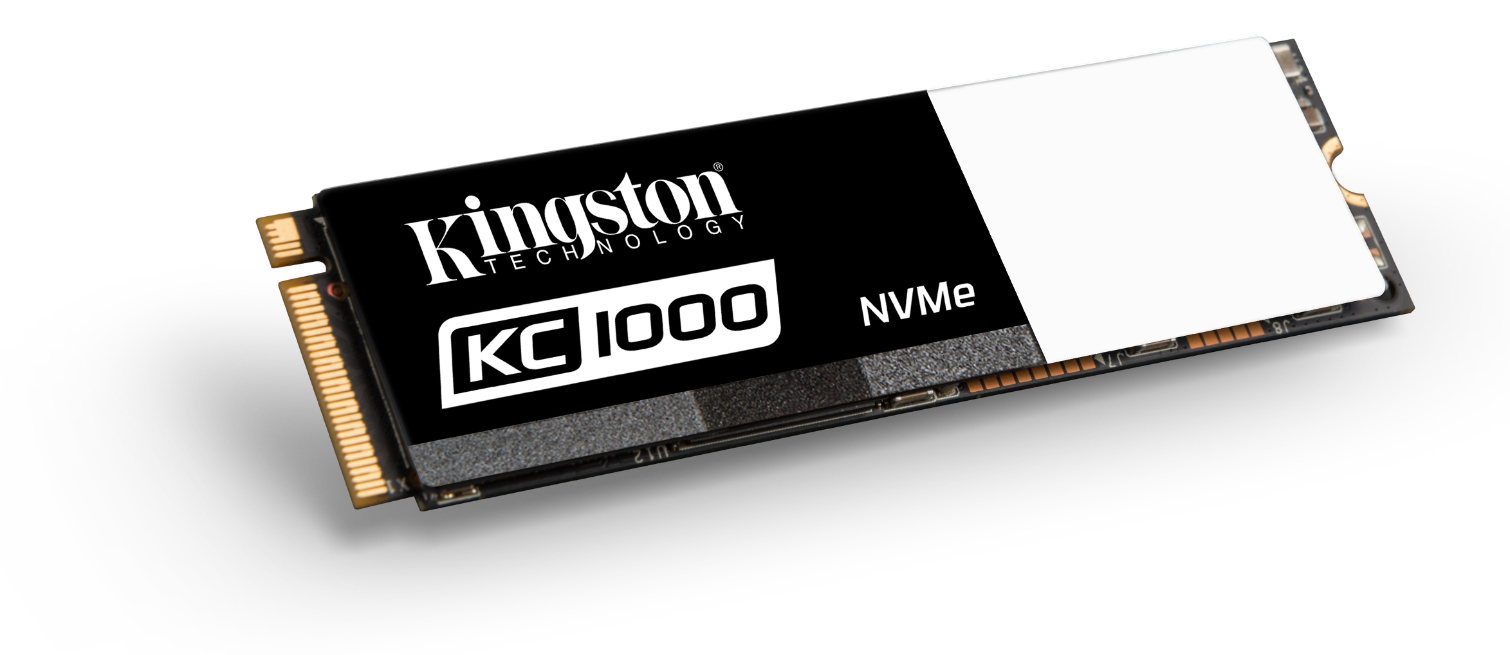Kingston's First NVMe SSD, The KC1000
Kingston has reintroduced the KC1000 NVMe SSD. We first saw the drive in January at CES, but the company wanted to hold the details until the official launch. Seemingly, that is in the very near future--mid June.
The KC series has historically targeted system builders and corporations upgrading systems en masse. Kingston released several client SSDs under the KC brand, and many of them were tuned for increased stability and longevity but share similar hardware with models from the standard consumer product line. The KC1000 press release seems to turn the tables and take this series in a slightly different direction.
"The demands of today’s performance power users are constantly being put to the test as new data-intensive applications push the boundaries of what can be achieved with even the market’s high performance professional workstations and most powerful gaming rigs,” said Ariel Perez, SSD business manager, Kingston. “KC1000 is the perfect solution to meet the needs of media and design professionals, gaming enthusiasts and anyone who needs ultra-low latency storage performance to end data bottlenecks. This native NVMe device offers one of the industry’s most powerful storage solutions for high-resolution content delivery, virtual reality applications, accelerated game play or a competitive edge for the creative professional on tight deadlines.”
Gamers, power users, and enthusiasts have always been directed to the HyperX brand, but in recent years that series shifted to target gamers exclusively. Kingston calls the KC1000 an "Ultimate Storage Upgrade for HD Video, PC Enthusiasts, Gaming and More." The release later identified a list of specific application categories the series will perform well in:
High-resolution video editingVirtual and augmented reality applicationsCAD software applicationsStreaming mediaGraphically intensive video gamesData visualizationReal-time analytics
It seems the KC series may begin to target a wider audience with the introduction of the first Kingston NVMe SSD.
Speeds And Feeds
| Product | Kingston KC1000 |
|---|---|
| Capacity Sizes | 240GB, 480GB, 960GB |
| Controller | Phison PS5007-E7 |
| NAND | Toshiba 15nm MLC |
| Interface / Protocol | PCIe 3.0 x4 / NVMe |
| Sequential Read | 2,700 MB/s |
| Sequential Write | 240GB: 900 MB/s480GB: 1,600 MB/s960GB: 1,600 MB/s |
| Random Read | 240GB: 225,000 IOPS480GB: 290,000 IOPS960GB: 290,000 IOPS |
| Random Write | 190,000 IOPS |
| Endurance | 240GB: 300TB480GB: 550TB960GB: 1PB |
| Warranty | 5-Years Limited |
The KC1000 series ships in three capacity sizes, but there are a total of six product SKUs. For each capacity, the drives ships as either a bare drive or with a half-height, half-length (HHHL) add-in card adapter. The performance coming from the Phision PS5007-E7 controller paired with Toshiba 15nm planar NAND looks strong. The sequential read performance reaches 2,700 MB/s, and the sequential writes are 900 MB/s for the 240GB model and 1,600 MB/s for the two largest-capacity drives. Random performance is also impressive, with up to 290,000 IOPS (225,000 for the 240GB). Users can reach up to 190,000 random write IOPS.
Get Tom's Hardware's best news and in-depth reviews, straight to your inbox.
Kingston backs the KC1000 series with a generous five-year limited warranty with ample endurance figures that reach as high as 1PB for the 960GB drive.

Chris Ramseyer was a senior contributing editor for Tom's Hardware. He tested and reviewed consumer storage.
-
mikewinddale 550 TBW for the 480 GB is pretty good, but not as amazing as the MyDigitalSSD BPX's 1400 TBW for the same capacity.Reply
I upgraded my current laptop (a brand new Lenovo E560) with a Kingston KC400 512 GB with 800 TBW as the data drive. (The boot drive is an OCZ RD400 256 GB.) With 800 TBW, I figure I can transplant it into my 2nd laptop in 3 years and it will still have several more years of life. -
bit_user Reply
Heh, with the way flash prices are going, I got a laptop (Lenovo ThinkPad 13) with a 256 GB M.2 drive and the intention of replacing it with something bigger/faster in 2-3 years.19735370 said:I upgraded my current laptop (a brand new Lenovo E560) with a Kingston KC400 512 GB with 800 TBW as the data drive. (The boot drive is an OCZ RD400 256 GB.) With 800 TBW, I figure I can transplant it into my 2nd laptop in 3 years and it will still have several more years of life.
Interestingly, the CPU in my laptop is listed as a field-replaceable part. So, I'll probably upgrade to a i7 and max out the RAM, at the same time. I've already had it open, and the CPU upgrade looks like it could be pretty simple. Should be almost like a new laptop. -
vern72 At least the performance is in the ballpark with 2700MB/s seq. read and 1600MB/s seq. write.Reply -
bit_user Reply
Perhaps, but we've got to see the low queue depth random I/O numbers. That's what people actually feel, most of the time, and what really sets apart the top performers from everything else.19736233 said:At least the performance is in the ballpark with 2700MB/s seq. read and 1600MB/s seq. write.
